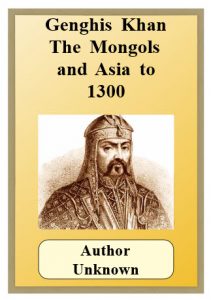THE KNIGHTS AT THEIR TOURNAMENTS, IN THEIR FINERY, ARMOUR AND EMBLEMS OF ANCESTRY, believed they were the foremost warriors in the world, while Mongol warriors thought otherwise. Mongol horses were small, but their riders were lightly clad and they moved with greater speed. These were hardy men who grew up on horses and hunting, making them better warriors than those who grew up in agricultural societies and cities. Their main weapon was the bow and arrow. And the Mongols of the early 1200’s were highly disciplined, superbly coordinated and brilliant in tactics.
The Mongols were illiterate, religiously shamanistic and sparsely populated, perhaps no more than around 700,000 in number, living in good-sized felt tents. They were herdsmen around an area called Karakorum. They had been moving across great distances on the grassy plains — steppe lands — north and east of China, frequently fighting wars over turf. Before 1200 they had been fragmented, with various tribes fighting one another — their divisions encouraged by neighbors such as the Ruzhen (Jin) of northern Manchuria, who wished to see the Mongols remain weak.
In the late 1100’s and early 1200’s a Mongol military leader named Temujin (Temüjin) was creating a confederation of tribes, Mongol and non-Mongol but which would be called Mongol. He was a good manager, collecting under him people of talent. And, when necessary, he warred. In 1202 his forces fought and defeated the Tatars to his immediate east. He had no hope of them, so he put the surviving men to the sword and distributed the women and children among other tribes.
